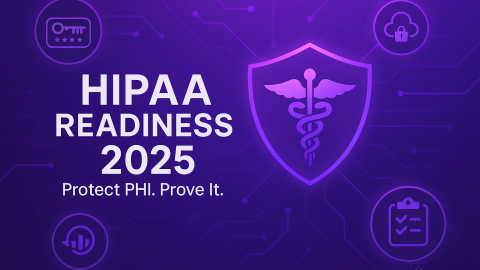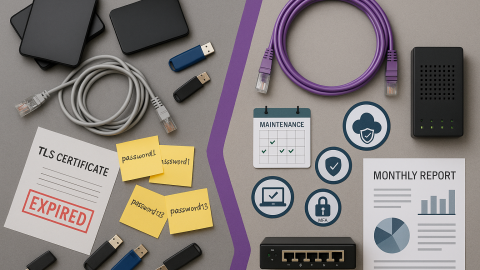Unpacking the latest rule tweaks, common audit fails, and the Affant playbook for airtight healthcare compliance.
2025: The Year HIPAA Tightens the Screws
If you handle protected health information, 2025 is not business as usual. HHS’s Office for Civil Rights (OCR) has rolled out several changes—some already final, others still in draft—but all pointing in the same direction: tougher expectations and sharper penalties.
- Reproductive-health privacy gets its own spotlight. A final rule issued in April 2024 places strict limits on disclosing reproductive-health–related PHI and forces every covered entity to publish a revamped Notice of Privacy Practices by February 2026. Waiting until 2026 is a recipe for non-compliance.
- “Recognized Security Practices” become your shield—if you can prove them. Beginning January 2025, OCR must look at whether you followed an accepted cybersecurity framework (think NIST CSF) for the previous 12 months before deciding fines or corrective-action plans.
- The Security Rule is being modernized. A 2025 proposal would convert encryption at rest, multifactor authentication (MFA), and beefed-up vendor oversight from “addressable” suggestions to non-negotiable mandates. Final language is expected before year-end.
- OCR’s formal audits are back. Fifty covered entities and business associates will be examined in the 2024-2025 cycle, with special focus on ransomware resilience and documentation quality.
- Fines keep climbing. Indexing for inflation pushed the possible maximum civil penalty for a single HIPAA violation above $2 million in 2025—proof that even “one-off mistakes” can blow up a budget.
Where Good Organizations Still Slip
Even mature compliance programs stumble over the same hidden gaps. One is incomplete asset inventories—IoMT pumps or smartbeds often sit outside the standard risk assessment. Another is the “set-and-forget” Business Associate Agreement that never spells out how quickly a breach must be reported. We also see evidence gaps: organizations deploy MFA but forget to log enrollment dates or link it to their risk-management plan. And year after year, the top OCR enforcement action remains Right-of-Access delays—records requests stuck in 45-day limbo because no one owns the stopwatch.
Closing the Gaps—A Narrative Walk-Through
Trace every new data flow. Gen-AI chatbots, marketing pixels, and remote-patient-monitoring apps move PHI in ways your 2020 diagrams never imagined. Redraw them, then revisit your risk register accordingly.
Refresh that NOPP early. The reproductive-health rule demands plain-English language about when you will and won’t comply with subpoenas. Getting legal review and board approval now beats a last-minute scramble.
Prove a year of “recognized practice.” Framework alignment isn’t just a white paper; it’s tickets showing patches applied within policy windows, SOC reports from your cloud host, and dated screenshots of MFA dashboards.
Encrypt everything that moves (and plenty that doesn’t). The pending Security-Rule update signals that “addressable” encryption is on borrowed time. Servers, SANs, flash drives, backups, laptops—if it stores ePHI, switch on encryption-at-rest and keep the logs.
Harden identity and access. Role-based provisioning plus conditional MFA for privileged or remote users is the new floor, not the ceiling.
Take vendor risk seriously. Review BAAs, insist on 24-hour breach-notice clauses, and retain the SOC 2 or HITRUST letter, not just the marketing sheet.
Run the fire drill. Table-top breach simulations reveal how quickly you really can trace, contain, and report an incident—and they produce priceless talking points for auditors.
Time your Right-of-Access workflow. Automated reminders at day 5 and high-level escalations at day 10 are simple, inexpensive fixes that keep you out of the penalty headlines.
Document, centralize, repeat. OCR cares as much about proof of compliance as compliance itself. A searchable portal for policies, risk analyses, training rosters, and evidence artifacts saves you hours (and legal fees) when the audit email lands.
The Affant Playbook—When “Good Enough” Isn’t
At Affant we’ve built a healthcare-focused security program around those very pressure points. Our complimentary IT audit benchmarks you against the 2025 Audit Protocol and the proposed Security-Rule updates, then delivers a roadmap tied to each citation—complete with quick wins and budget forecasts.
From there, our team can:
- Redraft your NOPP and BAAs to reflect reproductive-health protections and Part 2 alignment.
- Deploy and monitor MFA, full-disk encryption, and SIEM tooling, producing the logs OCR now reviews first.
- Spin up real-time compliance dashboards that flag drift long before it becomes an incident.
- Train your workforce with live phishing drills and role-based privacy modules that actually stick.
- Sit beside you—virtually or in person—when the auditors arrive, assembling evidence packets so you can stay focused on patient care.
Ready for Peace of Mind?
HIPAA’s trajectory is clear: more clarity for patients, more accountability for providers. Reach out to Affant today for your free IT audit and discover every compliance gap before an auditor—or an attacker—does. Let us sweat the policy minutiae while you concentrate on delivering exceptional healthcare.











